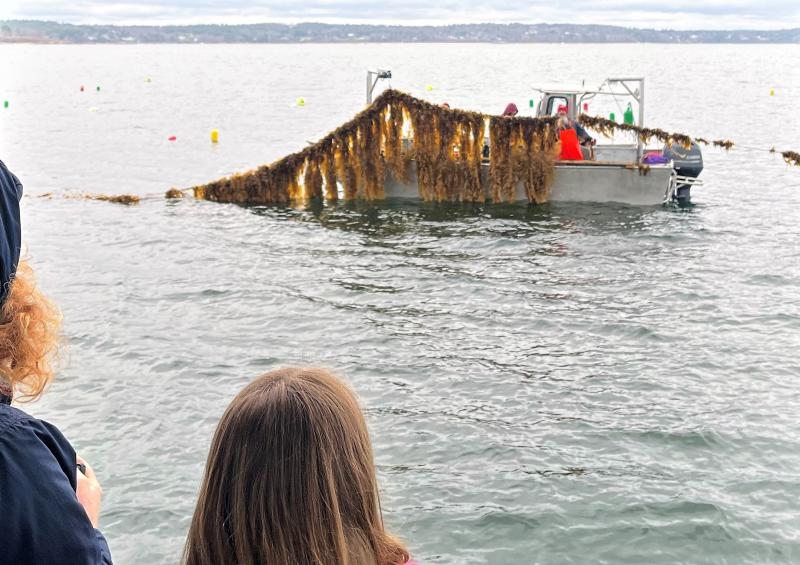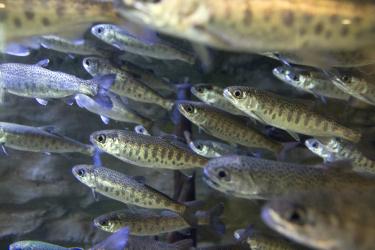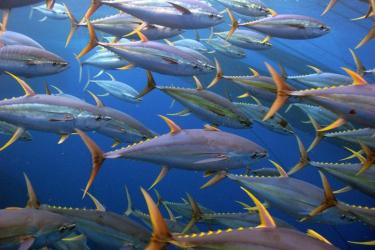April in New England may not be a month most people consider ideal for being on the water. But for Maine seaweed farmers, it’s the busiest time of year: the time to pull seaweed out of the water and celebrate the year’s harvest. That’s why people from as far away as Alaska and Norway flocked to Portland, Maine for Seaweed Week and the National Seaweed Symposium. They got to test out kelp kimchi, film packaging made of seaweed, and even rum daiquiris infused with kombu and wakame.
Seaweeds in the United States
Seaweeds in the wild have provided food, medicinal products, and ecosystem services to coastal and marine environments for millennia. But seaweed farming is relatively new in the United States. In fact, a recent study found that one in four people in the United States have never heard of seaweed farming.
In the Northeast, kelp farming has provided a way to maintain active working waterfronts year-round. It has diversified opportunities for seasonal coastal businesses and seafood industry sectors threatened by the impacts of climate change, such as lobster harvesters. Seaweed is a crop that requires little input for large returns and, like most vegetables, seaweeds are packed with essential vitamins and minerals.
For many regions, this makes seaweed a source of new hope for enhancing food security in harmony with the environment. For other communities, seaweed as a source of nourishment is a practice that has gone on for centuries.
Keolani Booth, Metlakatla Indian Community Tribal Council Member, addressed the growth of the U.S. seaweed industry as one of the Seaweed Symposium keynote speakers. He noted: “I hope what I have to share with you about the way that we have lived our lives for thousands of years can spread. We have a certain way of life that we’ve established, and you’re jumping in. Take some time to determine where you will fit.”
Coming Together Over Food
Seaweed Week—organized through a partnership between Maine Sea Grant, the Maine Aquaculture Association, and Heritage Seaweed—is an annual celebration of Maine’s spring kelp harvest and local seaweed products. Representatives from more than 60 breweries, distilleries, and restaurants across Maine learn about seaweed’s varied uses to create seaweed-inspired menus for the event. “Seaweed Week is always a fun excuse to play around with local ingredients you may not think to use in cocktails,” shared Hayley Wilson, Bartender at Hunt + Alpine Club. “For me, it's a welcome challenge to see how I can incorporate seaweed into drinks that are respectful to the ingredients and still appealing in a cocktail.”
As part of the celebration, chef Rob Dumas, Food Science and Innovation Coordinator at the University of Maine, collaborated with Maine Coast Sea Vegetables to lead a culinary workshop. He cooked seaweed-inspired dishes while highlighting the varied uses and flavor profiles of different seaweed species, grouped into browns, greens, and reds. For example, brown seaweeds like the sugar kelp grown in Maine waters have a subtle briny taste, similar to the widely known “kombu” in culinary circles. Their savory umami flavor makes them a great ingredient in stocks, seaweed salads, and noodles. Brown seaweeds can also be powdered to provide a source of iodine in breads, smoothies, and supplements. They can even help break down the cell walls of beans to make them more digestible for humans.
Many species of green seaweeds are wild harvested as “sea lettuce.” They can neutralize and emulsify ingredients in recipes for dressings or chimichurri. Seraphina Erhart, owner of Maine Coast Sea Vegetables, jokingly referred to sea lettuce as “the cilantro of the ocean. It has a very distinct mineral taste, so people either love it or hate it.”
Some red seaweeds, like Irish moss, are primarily used as a thickening agent in products like ice cream and toothpaste, and to make gels. Other red seaweeds, like dulse, are known for their tangy, salty, taste. They can be dried and eaten as a snack or paired with dairy in grilled cheese, corn chowder, or as a pizza topping. “Atlantic nori” is another red seaweed found in Maine. Its nutty texture is great in ravioli, but it is most commonly known as the seaweed used to wrap rolls of sushi.
Seaweed Hub's National Seaweed Symposiums
There is still a lot we are discovering about the opportunities and challenges of commercial seaweed production. This makes networks like NOAA’s National Seaweed Hub a critical resource. The hub is a collaborative project facilitated by the Sea Grant network. It provides practical science and information to inform policy and chart the course for sustainable expansion of the U.S. seaweed industry.
“We wanted to compile knowledge into effective, tangible tools that can be utilized by the industry,” said Anoushka Concepcion, project lead and associate extension educator at Connecticut Sea Grant. “By hosting conferences, developing solutions to emerging seaweed challenges together, and collaborating with experts to publish science that guides policy, we not only learn what we know, but also what we don’t know and need to figure out together.”
From interactive tools that help industry members navigate regulations to discussions about public perceptions of seaweed farming, a common theme emerged at the symposium. It all hinges on collaboration and patience. “There’s no one-size-fits-all approach,” said Joth Davis, principal and co-founder of Blue Dot Sea Farms. “You need to look out into each community where you’re thinking about farming and be cognizant of their needs, desires, interests, and how you can work together."




